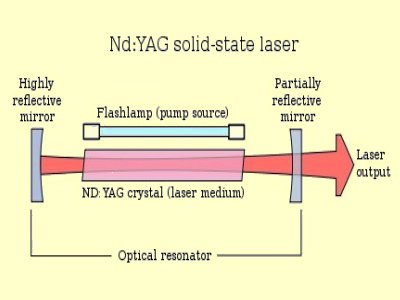LASER-TECHNOLOGY
The heart of a laser is formed by a solid-, a fluid- or a gaseous medium enclosed by
two mirrors, forming a so-called resonation chamber. The medium posses free
electrons that can be excited from a lower to a higher level of energy by absorption of
a photon. This excited electrons will almost immediately return to their ground state
under the emission of another photon whose wavelength is characteristic for the
used medium. This is called a spontaneous photon emission and since the
wavelength of the emitted photons is always the same, the emitted radiation is
monochromatic. When such a photon hits an already excited electron this electron
will return to its ground state while releasing a second photon. This is called a
stimulated emission and the two resulting photons will be identical both in wavelength
and in phase, resulting in a monochromatic coherent radiation. A stimulated emission
is initiated by one photon, resulting in the emission of an identical second one. In an
environment where there are more excited free electrons in the medium than
ground-state free electrons an avalanche may occur which will last until the number of
excited electrons has become too low. The situation in which there exist more
excited than ground state free electrons is called population inversion. Typically the
medium is forced and maintained into this state with help of an external radiation
source or an electric current in a process
that is called pumping. Once the laser is
"pumped" to "inversion", avalanches of
monochromatic coherent radiation occur
and this irregular process is transformed
into a continuous process by the two
mirrors on both sides of the medium. One
of the mirrors, the output coupler,
reflects most of the radiation but it also
allows a small part of the radiation to
pass through it. The two mirrors are
placed in an exactly opposite position
resulting in an ever increasing number of photons bouncing between the two mirrors.
A part of these photons will be responsible for the release of new photons while
another part passes through the output coupler. This radiation travels in only one
direction, perpendicular to the surface of the mirrors and the result is therefore a
monochromatic, coherent and collimated bundle of radiation, a laser beam. The
wavelength of this laser beam depends on the nature of the medium and may vary
from X-ray, ultraviolet, visible light, near- and far infrared to microwaves. Many lasers
operate in the visible part of the electromagnetic spectrum (called light) and this is
where the original acronym LASER stands for: Light Amplification by Stimulated
Emission of Radiation.


